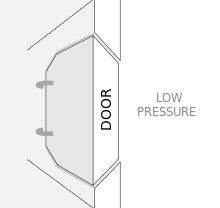Plug door

A plug door is a door designed to seal itself by taking advantage of pressure difference on its two sides and is typically used on aircraft with cabin pressurization. The higher pressure on one side forces the usually wedge-shaped door into its socket, making a good seal and preventing it from being opened until the pressure is released.
Non-plug doors rely on the strength of the locking mechanism to keep the door shut, whereas a plug door relies on the pressure differential to keep it shut.
The term "plug door" may also refer to a sliding bus door that is not actually held in place by pressure, but is mechanically wedged into place when closed.
Pressure-sealed plug doors
The following doors are self-sealing, being held in place by pressure and are true plug doors.
Aircraft
The plug door is often seen on aircraft with pressurized cabins.[1] Due to the air pressure within the aircraft cabin being higher than that of the surrounding atmosphere, the door seals itself closed as the aircraft climbs and the pressure differential increases. This prevents accidental opening of the door. In the event of a decompression, with there no longer being a pressure differential, the doors may be opened, and as such most airlines' operating procedures require cabin crew to keep passengers away from the doors until the aircraft has safely landed. On some aircraft the plug door opens partially inward, and through a complex hinge design can be tilted to fit through the fuselage opening, or the door may have locking hinged panels at the top and bottom edges that can make it smaller than the opening, so that it may be swung outward.
Plug doors are used on most modern airliners, particularly for the small passenger doors. However, since plug doors must open inward, the design is disadvantageous for cargo doors. Due to its large area, the cargo door on an airliner can not be swung inside the fuselage without taking up a considerable amount of valuable cargo space. For this reason, these doors often open outward and use a locking mechanism with multiple pins or hatch dogs to prevent opening while in flight.
Spacecraft
Inward opening plug hatches were used during the early U.S. space program on the "Block I" Apollo Command Module, because this ensured a reliable seal to the pressurised module. NASA decided to return to outward opening hatches on the Command Module after the plug hatch prevented rapid egress of the crew from the Apollo 1 fire, trapping and killing the three astronauts. Plug doors were retained for the CM docking hatch and the two hatches on the Apollo Lunar Module, as a fire in the low-pressure air atmosphere was more manageable; the Apollo 1 fire occurred in a high-pressure pure oxygen atmosphere. Plug doors were also used as the outer hatch doors on the Space Shuttle. Currently, they are used on the International Space Station, as well as on the hatch between the Orbital Module and Descent Module of the Russian Soyuz spacecraft.
Other plug doors
The following doors are sometimes referred to as plug doors but are not held in place by pressure and differ from ordinary doors only in that they slide or have heavy seals. There is some dispute that these are in fact plug doors.
Buses
A plug door on a bus has a pantographic hinge that moves the door panel outwards from its plug socket and then parallel to the side of the bus to clear the opening. On closing, the door is wedged and locked into the opening. This arrangement makes a very good airtight and soundproof seal but is usually limited to buses such as coaches that make infrequent stops as the door operation is slow and mechanically complex.
Passenger trains
Many passenger train carriages use plug doors. On commuter and regional trains doors of plug design take less room than sliding doors, but may restrict the compatibility of a car with high passenger platforms since these doors open outwards.
High-speed trains use plug doors because they can be made airtight, soundproof and reduce aerodynamic drag.
Refrigerator cars
Plug doors are often used on refrigerated freight cars and shipping containers. These tight-fitting doors are highly insulated and have locking mechanisms that wedge the door into place.
References
- ↑ "Relax, Passengers: Aircraft Doors Can't Open In Flight". Forbes. 2013-05-28. Retrieved 2013-09-25.